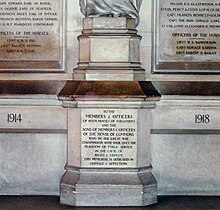
The Parliamentary War Memorial, also known as the Recording Angel Memorial, is a stone sculpture in Westminster Hall, unveiled in 1922, which commemorates the members of both Houses of Parliament of the United Kingdom who died in the First World War. It names 22 members of the House of Commons, 20 members of the House of Lords, and 9 senior members of staff, together with another 94 sons of members and officers of the House of Commons, who lost their lives in the war. (Sons of peers and of officers of the House of Lords are commemorated on the wooden panels of the House of Lords War Memorial in the Royal Gallery.) Above the memorial is a large stained glass window which commemorates members and staff of both Houses who died in the Second World War.
History
Planning for the Parliamentary War Memorial began in July 1917. A parliamentary committee chose a site below a large gothic window in St Stephen's Porch, at the south end of Westminster Hall. Designs were sought from Walter Tapper, George Frampton and Bertram Mackennal. A design by Australian sculptor Bertram Mackennal (1863–1931) was chosen, modifying an existing Victorian screen by adding the elements that now form the central section of the memorial: a winged figure representing the recording angel, flanked by two arched panels bearing names of the fallen. Mackennal's design also include a cupola above, with a Gothic arch and bronze statuettes of the patron saints of England, Scotland, Ireland and Wales. The two Portland stone panels and angel were inserted into the existing screen of Caen stone in 1921.
Modifications were made in 1922, removing the mullions from the flanking sections of the Victorian screen to insert six further panels, three on either side, to record the names of the sons of MPs and officers of the House of Commons killed in the war. Columns separate the central section from the flanking sections, each topped by a gilt-bronze statuette: one representing the virtue of Faith and the other Fortitude. The extended memorial was unveiled by Edward, Prince of Wales (later Edward VIII) in 1922.
The memorial suffered bomb damage in the Second World War. Early on 27 September 1940, a bomb fell in Old Palace Yard, blowing a hole in the window above the memorial, originally designed by Augustus Pugin. Masonry from the window's tracery fell on the memorial, knocking off the cupola, breaking off the angel's feet, and dislodging several panels of names. There were plans to extend the memorial to include the fallen of the Second World War, but eventually it was decided that a new stained glass window would become the memorial to members and staff of both Houses who died in that War. The new window was designed by Sir Ninian Comper and includes the service badges and armorial bearings or initials of 22 MPs, 34 Peers, and 5 members of staff (including two police officers). After structural repairs to St Stephen's Porch were completed, the restoration was undertaken from 1951. The cupola was left out of the final design, to prevent it obstructing the view of the new window. The bronze statue of St Andrew from the cupola is now in the Parliamentary Art Collection, but the statues of St George, St Patrick and St David have disappeared.
In 2018 former MP Gerald Arbuthnot, who was killed during the Battle of the Somme was added to the memorial, after it was noted he had been accidentally omitted for 96 years.
Related memorials
Further war memorials in the Houses of Parliament include books of remembrance for both Houses of Parliament, a memorial for other members of staff in Chancellors Court, a memorial for Parliamentary journalists in the Press Gallery, and 42 heraldic shields in the House of Commons, one for each MP killed on active service during the World Wars. Shields above the north and south entrances of the Commons Chamber honour Airey Neave and three other MPs who were killed by the Irish Republican Army and Irish National Liberation Army.
Notes
- ^ Bertram Mackennal's Parliamentary War Memorial – UK Parliament Archived 4 August 2014 at the Wayback Machine
- ^ Initial design – UK Parliament Archived 12 August 2014 at the Wayback Machine
- ^ Bomb Damage & Reconstruction – UK Parliament Archived 12 August 2014 at the Wayback Machine
- Stained glass window, Westminster Hall – UK Parliament
- Cole, Matt (10 November 2018). "Former MP killed in WW1 finally added to Parliament's memorial". BBC News. Retrieved 11 February 2020.
- World War One: The significance of Parliament during the Great War | Second reading
- The Palace of Westminster Official Guide. Houses of Parliament. 2012. p. 58. ISBN 978-0-95620-292-5.website www.parliament.uk
References
- Recording Angel memorial, Westminster Hall
- Bertram Mackennal's Parliamentary War Memorial
- Initial design
- Bomb Damage & Reconstruction
- Stained glass window, Westminster Hall
- List of names commemorated by the Westminster Hall War Memorial, First World War
- List of names commemorated by the Westminster Hall War Memorial, Second World War
- World War One: The significance of Parliament during the Great War
External links
- The records of the Committee on Peers War Memorial are held by the Parliamentary Archives
- Parliamentary Archives, Peers War Memorial
See also
51°30′00″N 0°07′31″W / 51.4999°N 0.1254°W / 51.4999; -0.1254
Categories: